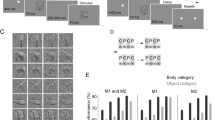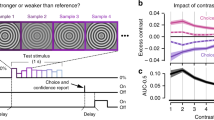Abstract
One of the most fascinating issues in neuroscience is how the brain makes decisions. Recent evidence points to the parietal cortex as an important locus for certain kinds of decisions. Because parietal neurons are also involved in movements, it has been proposed that decisions are encoded in an intentional, action-based framework based on the movements used to report decisions. An alternative or complementary view is that decisions represent more abstract information not linked to movements per se. Parallel experiments on categorization suggest that parietal neurons can indeed represent abstract categorical outcomes that are not linked to movements. This could provide a unified or complementary view of how the brain decides and categorizes.
This is a preview of subscription content, access via your institution
Access options
Subscribe to this journal
Receive 12 print issues and online access
$209.00 per year
only $17.42 per issue
Buy this article
- Purchase on Springer Link
- Instant access to full article PDF
Prices may be subject to local taxes which are calculated during checkout
Similar content being viewed by others
References
Glimcher, P.W. & Rustichini, A. Neuroeconomics: the consilience of brain and decision. Science 306, 447–452 (2004).
Padoa-Schioppa, C. Neurobiology of economic choice: a good-based model. Annu. Rev. Neurosci. (in the press).
Gold, J.I. & Shadlen, M.N. The neural basis of decision making. Annu. Rev. Neurosci. 30, 535–574 (2007).
Miller, E.K., Nieder, A., Freedman, D.J. & Wallis, J.D. Neural correlates of categories and concepts. Curr. Opin. Neurobiol. 13, 198–203 (2003).
Glimcher, P.W. Decisions, Uncertainty, and the Brain: the Science of Neuroeconomics (MIT Press, 2003).
Newsome, W.T., Britten, K.H. & Movshon, J.A. Neuronal correlates of a perceptual decision. Nature 341, 52–54 (1989).
Maunsell, J.H. & Newsome, W.T. Visual processing in monkey extrastriate cortex. Annu. Rev. Neurosci. 10, 363–401 (1987).
Johnston, K. & Everling, S. Neurophysiology and neuroanatomy of reflexive and voluntary saccades in non-human primates. Brain Cogn. 68, 271–283 (2008).
Andersen, R.A., Brotchie, P.R. & Mazzoni, P. Evidence for the lateral intraparietal area as the parietal eye field. Curr. Opin. Neurobiol. 2, 840–846 (1992).
Blatt, G.J., Andersen, R.A. & Stoner, G.R. Visual receptive field organization and cortico-cortical connections of the lateral intraparietal area (area LIP) in the macaque. J. Comp. Neurol. 299, 421–445 (1990).
Lewis, J.W. & Van Essen, D.C. Corticocortical connections of visual, sensorimotor, and multimodal processing areas in the parietal lobe of the macaque monkey. J. Comp. Neurol. 428, 112–137 (2000).
Snyder, L.H., Batista, A.P. & Andersen, R.A. Intention-related activity in the posterior parietal cortex: a review. Vision Res. 40, 1433–1441 (2000).
Goldberg, M.E., Bisley, J.W., Powell, K.D. & Gottlieb, J. Saccades, salience and attention: the role of the lateral intraparietal area in visual behavior. Prog. Brain Res. 155, 157–175 (2006).
Bisley, J.W. & Goldberg, M.E. Attention, intention, and priority in the parietal lobe. Annu. Rev. Neurosci. 33, 1–21 (2010).
Shadlen, M.N. & Newsome, W.T. Neural basis of a perceptual decision in the parietal cortex (area LIP) of the rhesus monkey. J. Neurophysiol. 86, 1916–1936 (2001).
Roitman, J.D. & Shadlen, M.N. Response of neurons in the lateral intraparietal area during a combined visual discrimination reaction time task. J. Neurosci. 22, 9475–9489 (2002).
Huk, A.C. & Shadlen, M.N. Neural activity in macaque parietal cortex reflects temporal integration of visual motion signals during perceptual decision making. J. Neurosci. 25, 10420–10436 (2005).
Gold, J.I. & Shadlen, M.N. The influence of behavioral context on the representation of a perceptual decision in developing oculomotor commands. J. Neurosci. 23, 632–651 (2003).
Shadlen, M.N., Kiani, R., Hanks, T.D. & Churchland, A.K. Neurobiology of decision making: an intentional framework. in Better Than Conscious? Decision Making, the Human Mind, and Implications for Institutions (Engel, C. & Singer, W., eds.) 71–102 (MIT Press, 2008).
Kable, J.W. & Glimcher, P.W. The neurobiology of decision: consensus and controversy. Neuron 63, 733–745 (2009).
Freedman, D.J. & Assad, J.A. Experience-dependent representation of visual categories in parietal cortex. Nature 443, 85–88 (2006).
Freedman, D.J., Riesenhuber, M., Poggio, T. & Miller, E.K. Categorical representation of visual stimuli in the primate prefrontal cortex. Science 291, 312–316 (2001).
Freedman, D.J., Riesenhuber, M., Poggio, T. & Miller, E.K. A comparison of primate prefrontal and inferior temporal cortices during visual categorization. J. Neurosci. 23, 5235–5246 (2003).
Williams, Z.M., Elfar, J.C., Eskandar, E.N., Toth, L.J. & Assad, J.A. Parietal activity and the perceived direction of ambiguous apparent motion. Nat. Neurosci. 6, 616–623 (2003).
Toth, L.J. & Assad, J.A. Dynamic coding of behaviourally relevant stimuli in parietal cortex. Nature 415, 165–168 (2002).
Stoet, G. & Snyder, L.H. Single neurons in posterior parietal cortex of monkeys encode cognitive set. Neuron 42, 1003–1012 (2004).
Gottlieb, J. From thought to action: the parietal cortex as a bridge between perception, action, and cognition. Neuron 53, 9–16 (2007).
Bennur, S. & Gold, J.I. Distinct representations of a perceptual decision and the associated oculomotor plan in monkey area LIP. J. Neurosci. (in the press).
Freedman, D.J. & Assad, J.A. Distinct encoding of spatial and nonspatial visual information in parietal cortex. J. Neurosci. 29, 5671–5680 (2009).
Ferrera, V.P., Yanike, M. & Cassanello, C. Frontal eye field neurons signal changes in decision criteria. Nat. Neurosci. 12, 1458–1462 (2009).
Wunderlich, K., Rangel, A. & O'Doherty, J.P. Neural computations underlying action-based decision making in the human brain. Proc. Natl. Acad. Sci. USA 106, 17199–17204 (2009).
Author information
Authors and Affiliations
Corresponding authors
Ethics declarations
Competing interests
The authors declare no competing financial interests.
Rights and permissions
About this article
Cite this article
Freedman, D., Assad, J. A proposed common neural mechanism for categorization and perceptual decisions. Nat Neurosci 14, 143–146 (2011). https://doi.org/10.1038/nn.2740
Published:
Issue Date:
DOI: https://doi.org/10.1038/nn.2740
This article is cited by
-
Uncertainty modulates visual maps during noninstrumental information demand
Nature Communications (2022)
-
Donut-like organization of inhibition underlies categorical neural responses in the midbrain
Nature Communications (2022)
-
Causal contributions of parietal cortex to perceptual decision-making during stimulus categorization
Nature Neuroscience (2019)
-
Macaque dorsal premotor cortex exhibits decision-related activity only when specific stimulus–response associations are known
Nature Communications (2019)
-
Cross-decoding supramodal information in the human brain
Brain Structure and Function (2018)



